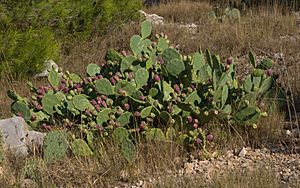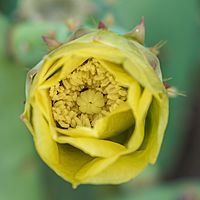Erect prickly pear facts for kids
Quick facts for kids Erect prickly pear |
|
|---|---|
 |
|
| Opuntia stricta with fruits | |
| Conservation status | |
| Scientific classification | |
| Genus: |
Opuntia
|
| Species: |
stricta
|
Opuntia stricta, also known as the erect prickly pear, is a type of large cactus. It grows naturally in warm, coastal areas of the Americas, especially around the Caribbean Sea. In Spanish, it is sometimes called nopal estricto. This cactus was first described in 1803 by Adrian Hardy Haworth. In 1812, he moved it to the Opuntia group of plants.
Contents
What Does the Erect Prickly Pear Look Like?
This cactus is a bushy plant that can grow up to 2 m (6.6 ft) (about 6.5 feet) tall. In spring and summer, it produces bright lemon yellow flowers. After the flowers, purplish-red fruits appear.
The flat, oval-shaped parts of the plant, called pads, are blue-green. They are usually 10 to 25 cm (3.9 to 9.8 in) (4 to 10 inches) long and 6 to 25 cm (2.4 to 9.8 in) (2.5 to 10 inches) wide.
The pads have small, brownish spots called areoles. These spots often have one or more yellowish spines, especially near the edges and top. They also have tiny, barbed hairs called glochids, which are yellow and 2 to 6 mm (0.079 to 0.236 in) (0.08 to 0.24 inches) long. The spines are usually 0.5 to 5 cm (0.20 to 1.97 in) (0.2 to 2 inches) long and stick out from the plant.
The yellow to yellowish-orange flowers grow alone. They are about 5 to 6 cm (2.0 to 2.4 in) (2 to 2.4 inches) long and 4 to 6 cm (1.6 to 2.4 in) (1.6 to 2.4 inches) wide. These flowers only last for a short time and are good for bees.
The fruits are smooth, purple-red, and shaped like an upside-down egg. They are about 2.5 to 3.5 cm (0.98 to 1.38 in) (1 to 1.4 inches) long and are covered with many glochids. Each fruit can hold 60 to 180 seeds, which can stay alive for over 10 years! Birds and other animals like to eat these fruits, which helps spread the seeds.
The gooey substance inside the cactus pads can be used to treat burns and skin infections. The fruits are also safe to eat.
Where Does the Erect Prickly Pear Grow?
Opuntia stricta naturally grows in sandy coastal areas. You can find it in places like South Carolina, Georgia, Florida, Texas, Mississippi, and Alabama in the United States. It also grows in Bermuda, the Caribbean, eastern Mexico, Central America, and northern South America (in Venezuela and Ecuador). This cactus is a big part of the plant life in the Bahamian dry forests in the Bahamas and the Turks and Caicos Islands.
When It Becomes an Invasive Species
Sometimes, a plant or animal is moved to a new place where it doesn't naturally belong. If it grows too much and harms the local environment, it's called an invasive species. Opuntia stricta has become an invasive species in other parts of the world, including Africa (like Madagascar), Australia, and southern Asia.
In South Africa and Kenya, it is considered an invasive plant. In Australia, people used a special moth called Cactoblastis cactorum to control it. This moth eats the cactus and helps keep its numbers down. Another insect, Dactylopius opuntiae, also helps control it.
In Sri Lanka, this cactus has taken over a large coastal area, especially in Bundala National Park. It covers hundreds of acres of sand dunes and nearby forests, making some areas impossible for people and animals to get through. Monkeys, birds, and other animals spread the seeds by eating the fruits. People also accidentally spread it when they cut down the cactus but leave pieces behind, which then grow into new plants.
Interestingly, the same moth that helps control the cactus in Australia, Cactoblastis cactorum, was found in Texas in 2017. This moth is very good at destroying this cactus, which is a native plant in Texas. So, what helps in one place can cause problems in another!
See also
 In Spanish: Nopal tunero costero para niños
In Spanish: Nopal tunero costero para niños
- Bahamian dry forests
- Prickly pears in Australia




